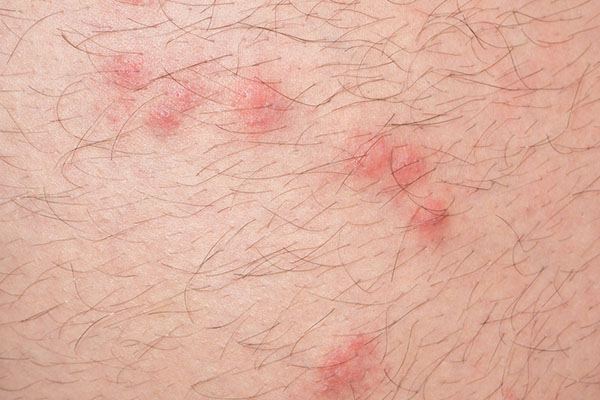Wondering what a flea bite looks like? Take a look at a few characteristics and learn tips to help keep fleas off your pets and out of your home.

Fleas are small, wingless parasites that depend on the blood of other animals for nutrition. Throughout history they have been blamed for diseases and plagues because of their tendency to switch from feeding on hosts like rats or dogs to feeding on humans. The most common type of fleas are cat fleas, but human fleas exist too. Both are willing to bite you. But how do you know if you've been bitten by a flea?
What do flea bites look like?
Flea bites cause red, round-shaped bumps on the skin, surrounded by a halo shape. The severity of the itch depends on the person being bit, but most experience extreme itchiness; those who are allergic may also develop hives or rashes. Allergic reactions can take up to 24 hours to occur.
How can you identify a flea bite?
It is difficult to tell the difference between a flea bite and a mosquito bite. Similar red spots can also be the result of a different type of insect bite or skin reaction. Noting how frequently the bites occur, and at what times of day or night, can help narrow down the culprits. Finding evidence of the actual bug is best. If the bites persist, a pest management professional can identify what type of infestation you might have. You should seek medical advice if you become concerned.
Why do flea bites itch so much?
During a feeding session, fleas release saliva containing an anticoagulant into your bloodstream. This increases your flow of blood, making it easier for the flea to feed. But when the flea is done, it leaves trace amounts of saliva on your skin. Your body processes the leftover saliva as a foreign substance. In response, it sends a warning signal to your immune system, triggering it to start producing histamine. The release of histamine causes the bite to swell, resulting in the small red bump that is common with flea bites. This process happens when mosquitoes bite too, which is part of the reason why the bites look similar.
What causes an allergic reaction?
Everyone responds differently to insect bites. Some people build up a tolerance to mosquito saliva. As it becomes less foreign to the body, there is a lower chance for an allergic reaction. Since flea bites happen less frequently than mosquito bites, more reactions and itchiness can occur.
An allergic reaction occurs when your body has an exaggerated response to the saliva. In hypersensitive individuals, the body processes the saliva as toxic and increases the amount of histamine released, causing rashes or hives. Animals can also have an allergic reaction.
How do humans get fleas?
A flea can jump more than 200 times its body length. On a human scale, that's nearly 400 meters. The Olympic record for the long jump is less than 10 meters. With that knowledge, it is easy to understand how a flea might jump from a household pet to you. But pet owners aren't the only ones at risk. Fleas can also live in your backyard and feed on outdoor animals, or find food sources in your neighbor's yard.
What do flea bites look like? How can you be sure you are dealing with fleas? Has your home been infested? These questions can be difficult to answer alone. Fleas can pose a threat to you, your family and your pets. If you are concerned about a flea infestation, call a pest management professional. A Terminix® Service Technician will rid your home of any unwelcome invaders and recommend the best prevention methods to keep fleas out.



